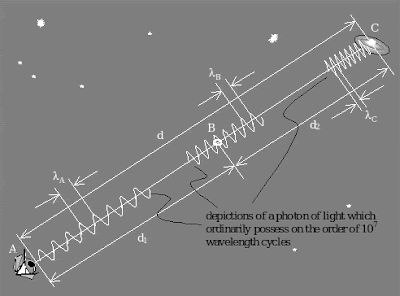The Theoretical Significance of a Logarithmic Distance-Redshift Relationship

There is something very compelling about a logarithmic functional form for the distance-redshift relation in observational cosmology. In fact, it is so compelling as to seem logically necessary as the form of that relationship — whether that fact is generally acknowledged or not, which of course…it is not.
To adequately understand this, let us look at what is involved in light being redshifted along a propagation path between emission and observation. Suppose there is an observer at point A for which a telescope on earth would suffice as an instance. And suppose that there is an ensemble of atoms in a star in a distant galaxy that we will refer to as point C that emit light at a specific wavelength associated with the spectra of a particular element. These atoms emit photons of light that can ultimately be observed by the telescope at A. If there is a distance-related redshift in the spacetime where all this takes place, then the wavelength of the light λAobserved at A will be related to the emission wavelength λCemitted at location C according to the redshift definition:
ZAC = ( λA − λC ) / λCThis is true no matter what the separation between A and C or anything else. It's just a definition. For physical reasons ZACmust be a continuously increasing function of the separation AC. So, let us define the redshift-related parameter ζ(d) as a continuous function of the separation d = AC as follows:
ζ(d) = ZAC + 1 = λA / λC
Since ζ(d) applies to for any separation, we should be able to place an observer at any point B along the light path from C to A, where d1= AB and d2 = BC, with the observed radiation exhibiting redshifts as follows:
&zeta(d1) = λA / λB and &zeta(d2) = λB / λCTherefore, over the total distance for which d = d1 + d2 the following relation must apply:
ζ(d1 + d2) = ζ(d1) . ζ(d2),And as a necessary consequence of this relation, we must have that:
ζ(d) = e αd = e α ( d1 + d2 ).And, of course, the inverse functionality must be:
d(ζ) = ln (ζ)
The "standard model" embraces a broad class of disparate alternatives loosely associated by adherence to Hubble's hypothesis and one form or another of Einstein's theory of general relativity. The Einstein — de Sitter model is but one of the simpler of these alternatives that exhibits a "flat" spacetime, because of which it is frequently discussed for didactic purposes, although it is generally disparaged as a somewhat naïve candidate for serious consideration. This short shrift seems ill-advised to the author in light of the interesting fact that a key feature of the Einstein — de Sitter model (unlike the others that are considered more viable) is that the distance-redshift relation is given by the logarithmic form.
Although the Einstein — de Sitter model is virtually never considered a viable contender by current cosmologists for the ultimate acceptance, its logarithmic form of the distance-redshift relation is generally used for convenience in analyzing associated phenomena because it so closely fits the actual data as distances to observed objects increase. Strange isn't it?
The preceding discussion explains the situation depicted in the figure below.
It is worth considering what would be implied by a relationship other than one involving the logarithm: What is involved is whether or not homogeneity applies to this relationship.
The seeming improbability of, but nonetheless presumed, failure of the logic we have described above is what has contributed so substantially to presumptions of the supposed evolution of developments in our universe. But if one decouples redshifting as an observed phenomenon (whatever its cause) from constraints imposed by whatever causes it according to one cosmological theory or other, then the logarithmic relationship to distance continues to make logical sense as we have shown above. We will be told, of course, that to presume that distances could be linearly additive if space itself is nonlinearly distorted would itself be an improbability. But would it? Even along a curved path the distance along that path is linearly additive as the basis for the integration of distance along infinitesimal line segments.
In the next figure we have drawn a situation similar to that shown in figure 1 except that space is such that line of sight distance is curved along a light path through space. In this case, in addition to observers A and B, we have observer B capable of emitting light from a separate source at the moment of his observation of the light from C which is set to resonate at precisely the same frequency (wavelength) as the radiation he observes. Let us analyze the possibilities here.
As before, we must now have that ζ(d1) = λA / λBand ζ(d2) = λB1 / λC. This would seem to apply by reason of the definition of redshift, if the source of the radiation of wavelength λB1is indeed set up to equal that of λB. This can be verified by the digital communication from B to A independent of the redshift impact on that link if A's antenna is properly tunable. Then as long as there is a general formula applicable throughout space and time relating redshift and distance,
d ← f(Z+1) and Z+1 ← ζ(r)If the peculiar functionality of the inverses f(x) and ζ(y) were independent of position in spacetime (i. e., if spacetime is indeed homogeneous), then the logarithmic/exponential relationships must apply. It is the ad hoc denial of this cosmological principle that had reigned supreme since Copernicus that empowers the standard model with the freedom to deny an otherwise logical premise.














No comments:
Post a Comment